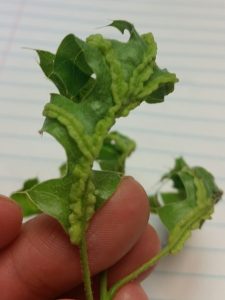
Oak Vein Pocket Gall is characterized by lumpy bumpy veins on the back of oak leaves and is caused by the feeding of tiny gall midge larvae. Photo by Brenda Nordin.
The photo here shows oak vein pocket gall. This gall is caused by a tiny gall midge (fly) and causes the distortions that you see. It’s not really a problem for the tree, doesn’t cause premature defoliation, and won’t kill the leaves, but it will cause the leaves to be a bit gnarled for the remainder of the growing season. I’ve had a couple reports of this from Shawano and Brown Counties this summer so far. More info can be found on the Kansas State Research and Extension website.
Written by: Linda Williams, forest health specialist, Woodruff, (Linda.Williams@wisconsin.gov), 715-356-5211 x232.

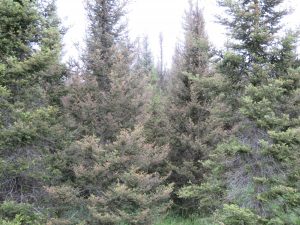
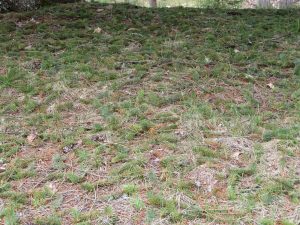
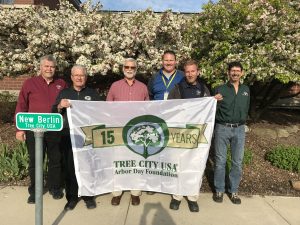 Breathe in… breathe out. The clear air that fills your lungs has been purified by trees. Clean air is one of the many ecological, economic and social benefits trees provide us. Trees also reduce crime rate, increase property values, reduce heating and cooling costs, increase tests scores, beautify communities, and provide lumber by-products. In late April, people around the world, both old and young, took time to celebrate these and other benefits by participating in Arbor Day celebrations.
Breathe in… breathe out. The clear air that fills your lungs has been purified by trees. Clean air is one of the many ecological, economic and social benefits trees provide us. Trees also reduce crime rate, increase property values, reduce heating and cooling costs, increase tests scores, beautify communities, and provide lumber by-products. In late April, people around the world, both old and young, took time to celebrate these and other benefits by participating in Arbor Day celebrations. Green Tier, a voluntary program administered by the DNR, works with entities conducting their business beyond compliance requirements and looking for ways to improve. Currently there are 82 participants with 248 facilities in the program along with six Green Tier Charters, including the
Green Tier, a voluntary program administered by the DNR, works with entities conducting their business beyond compliance requirements and looking for ways to improve. Currently there are 82 participants with 248 facilities in the program along with six Green Tier Charters, including the 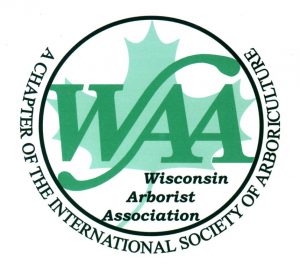 The
The  A recently published report from The Nature Conservancy titled “Planting Healthy Air,” detailed which cities could benefit most from tree plantings, focusing on the benefit they could gain from the heat and PM (particle matter) reduction credited to tree plantings. This report found that investing $4 per resident in these cities for tree planting could improve the health of millions, further showcasing trees as a cost-effective solution for air pollution and heat islands, among many other urban difficulties.
A recently published report from The Nature Conservancy titled “Planting Healthy Air,” detailed which cities could benefit most from tree plantings, focusing on the benefit they could gain from the heat and PM (particle matter) reduction credited to tree plantings. This report found that investing $4 per resident in these cities for tree planting could improve the health of millions, further showcasing trees as a cost-effective solution for air pollution and heat islands, among many other urban difficulties.